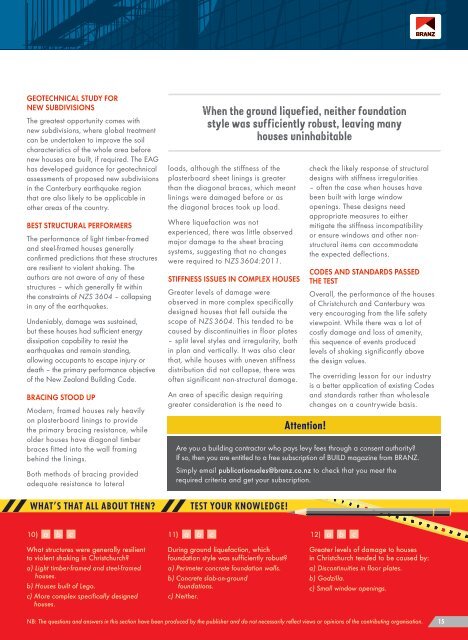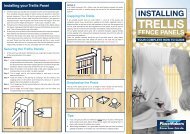what we learned from christchurch taking the risk out ... - PlaceMakers
what we learned from christchurch taking the risk out ... - PlaceMakers
what we learned from christchurch taking the risk out ... - PlaceMakers
You also want an ePaper? Increase the reach of your titles
YUMPU automatically turns print PDFs into web optimized ePapers that Google loves.
GEOTECHNICAL STUDY FORNEW SUBDIVISIONSThe greatest opportunity comes withnew subdivisions, where global treatmentcan be undertaken to improve <strong>the</strong> soilcharacteristics of <strong>the</strong> whole area beforenew houses are built, if required. The EAGhas developed guidance for geotechnicalassessments of proposed new subdivisionsin <strong>the</strong> Canterbury earthquake regionthat are also likely to be applicable ino<strong>the</strong>r areas of <strong>the</strong> country.BEST STRUCTURAL PERFORMERSThe performance of light timber-framedand steel-framed houses generallyconfirmed predictions that <strong>the</strong>se structuresare resilient to violent shaking. Theauthors are not aware of any of <strong>the</strong>sestructures – which generally fit within<strong>the</strong> constraints of NZS 3604 – collapsingin any of <strong>the</strong> earthquakes.Undeniably, damage was sustained,but <strong>the</strong>se houses had sufficient energydissipation capability to resist <strong>the</strong>earthquakes and remain standing,allowing occupants to escape injury ordeath – <strong>the</strong> primary performance objectiveof <strong>the</strong> New Zealand Building Code.BRACING STOOD UPModern, framed houses rely heavilyon plasterboard linings to provide<strong>the</strong> primary bracing resistance, whileolder houses have diagonal timberbraces fitted into <strong>the</strong> wall framingbehind <strong>the</strong> linings.Both methods of bracing providedadequate resistance to lateralWHAT’S THAT ALL ABOUT THEN?When <strong>the</strong> ground liquefied, nei<strong>the</strong>r foundationstyle was sufficiently robust, leaving manyhouses uninhabitableloads, although <strong>the</strong> stiffness of <strong>the</strong>plasterboard sheet linings is greaterthan <strong>the</strong> diagonal braces, which meantlinings <strong>we</strong>re damaged before or as<strong>the</strong> diagonal braces took up load.Where liquefaction was notexperienced, <strong>the</strong>re was little observedmajor damage to <strong>the</strong> sheet bracingsystems, suggesting that no changes<strong>we</strong>re required to NZS 3604:2011.STIFFNESS ISSUES IN COMPLEX HOUSESGreater levels of damage <strong>we</strong>reobserved in more complex specificallydesigned houses that fell <strong>out</strong>side <strong>the</strong>scope of NZS 3604. This tended to becaused by discontinuities in floor plates– split level styles and irregularity, bothin plan and vertically. It was also clearthat, while houses with uneven stiffnessdistribution did not collapse, <strong>the</strong>re wasoften significant non-structural damage.An area of specific design requiringgreater consideration is <strong>the</strong> need toTEST YOUR KNOWLEDGE!Attention!check <strong>the</strong> likely response of structuraldesigns with stiffness irregularities– often <strong>the</strong> case when houses havebeen built with large windowopenings. These designs needappropriate measures to ei<strong>the</strong>rmitigate <strong>the</strong> stiffness incompatibilityor ensure windows and o<strong>the</strong>r nonstructuralitems can accommodate<strong>the</strong> expected deflections.CODES AND STANDARDS PASSEDTHE TESTOverall, <strong>the</strong> performance of <strong>the</strong> housesof Christchurch and Canterbury wasvery encouraging <strong>from</strong> <strong>the</strong> life safetyviewpoint. While <strong>the</strong>re was a lot ofcostly damage and loss of amenity,this sequence of events producedlevels of shaking significantly above<strong>the</strong> design values.The overriding lesson for our industryis a better application of existing Codesand standards ra<strong>the</strong>r than wholesalechanges on a countrywide basis.Are you a building contractor who pays levy fees through a consent authority?If so, <strong>the</strong>n you are entitled to a free subscription of BUILD magazine <strong>from</strong> BRANZ.Simply email publicationsales@branz.co.nz to check that you meet <strong>the</strong>required criteria and get your subscription.10) a b c11) a b c12) a b cWhat structures <strong>we</strong>re generally resilientto violent shaking in Christchurch?a) Light timber-framed and steel-framedhouses.b) Houses built of Lego.c) More complex specifically designedhouses.During ground liquefaction, whichfoundation style was sufficiently robust?a) Perimeter concrete foundation walls.b) Concrete slab-on-groundfoundations.c) Nei<strong>the</strong>r.Greater levels of damage to housesin Christchurch tended to be caused by:a) Discontinuities in floor plates.b) Godzilla.c) Small window openings.NB: The questions and ans<strong>we</strong>rs in this section have been produced by <strong>the</strong> publisher and do not necessarily reflect views or opinions of <strong>the</strong> contributing organisation.15
















